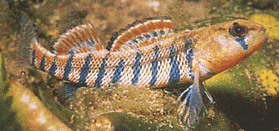Classification
Common Name: Orangethroat Darter
Taxonomy

Domain
Eukaryota
Kingdom
Animalia
Phylum Chordata
Class Actinopterygii
Order Perciformes
Family
Percidae
Genus
Etheostoma
Species Etheostoma
spectabile
The origin of the orangethroat darters scientific name
appears to come from the Greek language. The word "etheo" in Greek
means to strain and the Greek word "stoma" means mouth (Fish Base).
And the word "spectabile" is commonly considered to be of Latin
origin meaning outstanding (Latdict).
The domain of the fish species E. spectabile is
Eukaryota which includes organism phyla with membrane bound
organelles. This classification separates this domain of phyla from
the other domains Archaea and Bacteria which lack membrane bound
organelles. The orangethroat darter is classified further into the
kingdom Animalia. This specification is for organisms that are
multicellular and don't make their own food (they are heterotrophic). This
separates species that are multicellular but are autotrophic (plants
and fungi, for example). The orangethroat darter is considered
further to be a member of the phylum Chordata because they possess a
notochord, commonly associated with the vertebrates that are a part
of this phylum as well (Encyclopedia of Life).
The next step in this species taxonomical
classification is the class Actinopterygii. This class of organisms
is defined by the presence of ray-fins. The orangethroat darter is
morphologically similar to the species of perch so this places the
Darter into the order Perciformes (meaning perch-like) and the
family Percidea (perches). The Darter
is lastly defined into the Genus Etheostoma and the species spectabile
(Encyclopedia of Life).
Additional orangethroat darter taxonomy information can be accessed
from Animal Diversity Web and the
Encyclopedia of Life.
___________________________________________________________________
